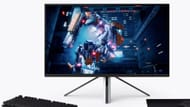Gamers typically have to decide whether they want to get a 24-inch or 32-inch monitor, as these are the most readily available variants with high refresh rates. While both sizes have their own advantages and disadvantages, the ideal choice largely depends on the type of games you play, your desk setup, and personal preferences.
32-inch monitors provide a more immersive gaming experience by offering a larger viewing area. This makes them particularly great for experiencing story-based titles or games with large open areas. On the other hand, 24-inch monitors offer a higher pixel density due to smaller screen sizes, resulting in sharper visuals and less pixelation even at 1080p resolution.
In this article, we will take a deeper look at some of the key differences between the two resolutions to help you decide between a 24-inch and 32-inch monitor for your gaming needs.
Note: This article is subjective and based on the writer’s opinions.
24-inch vs 32-inch monitor: Pixel density and resolution

Pixel density refers to the number of pixels packed across a specific area. The higher the number, the sharper the image output. For example, a 24-inch 1080p monitor has a higher pixel density than a 32-inch 1080p monitor because its pixels are packed in a smaller surface area.
This means that at lower resolutions like 1080p or 1440p, a 24-inch monitor offers a more crisp image output compared to a 32-inch monitor. However, when the resolution increases to 4K, the difference in pixel density between 24-inch vs 32-inch monitor sizes becomes less significant due to the massive number of pixels at 4K resolution.
Overall, if you cannot afford a 4K display, it is better to opt for a 24-inch monitor with 1080p or 1440p resolution. However, if you're going fo 4K, a 32-inch 4K monitor will provide a better viewing experience.
24-inch vs 32-inch monitor: Sitting distance

Sitting distance plays a significant role in the 24-inch vs 32-inch monitor size debate. Ideally, you should be able to see the entire screen comfortably without excessive head movement. A 32-inch monitor might feel like a cinematic experience on paper but if you have a shallow desk, it can be overbearing and cause eye and neck strain.
Similarly, a 24-inch monitor on a bigger desk will require you to lean in to see the details on the screen which can cause eye strain during long gaming sessions.
Overall, If you have a spacious desk, then a 32-inch monitor might be comfortable, but if you sit close to the screen, a 24-inch monitor might be a better fit.
24-inch vs 32-inch monitor: Single-player games

A 32-inch monitor can be a great choice if you generally play single-player or story-driven games. The larger screen size allows you to fully immerse yourself in the visuals and appreciate the cinematic experience of these games. In games like Senua’s Saga: Hellblade 2, a 32-inch monitor can make you feel like you're truly a part of the world.
While 24-inch monitors are perfectly viable for single-player games, the limited screen area might not match the experience often found on a larger screen.
24-inch vs 32-inch monitor: Multiplayer games

If you’re a competitive player where every detail and every enemy movement matters, a 24-inch monitor shines. The smaller screen size allows you to see the entire playing field at a glance, allowing you to make quick maneuvers in a fast-paced title.
While you can use a 32-inch monitor for competitive gaming, they are often too big to soak in all the information, causing you to miss out on enemy location and movement in your peripheral vision area.
For example, imagine the chaos in a high-stakes Apex Legends match. On a 24-inch monitor, every enemy movement is within your field of view, which gives you vital information to react accordingly. On a 32-inch monitor, some of this information may get lost due to the limited field of view of the human eye.
24-inch vs 32-inch monitor: Conclusion
Monitor size is a very subjective topic and the “best” monitor size usually depends on your gaming needs and preferences. If you want sharp visuals but your desk is small, consider a 1080p or 1440p 24-inch monitor. However, if you generally play story-driven games in a laid-back position, a 4K 32-inch monitor may be suitable for you.
Check out more monitor-related articles:
Is a 1080p screen good enough in 2024? || 4K vs 1440p monitors || 5 best gaming monitors in 2024
